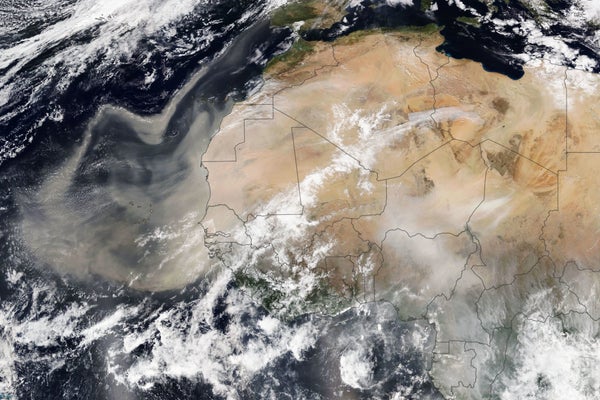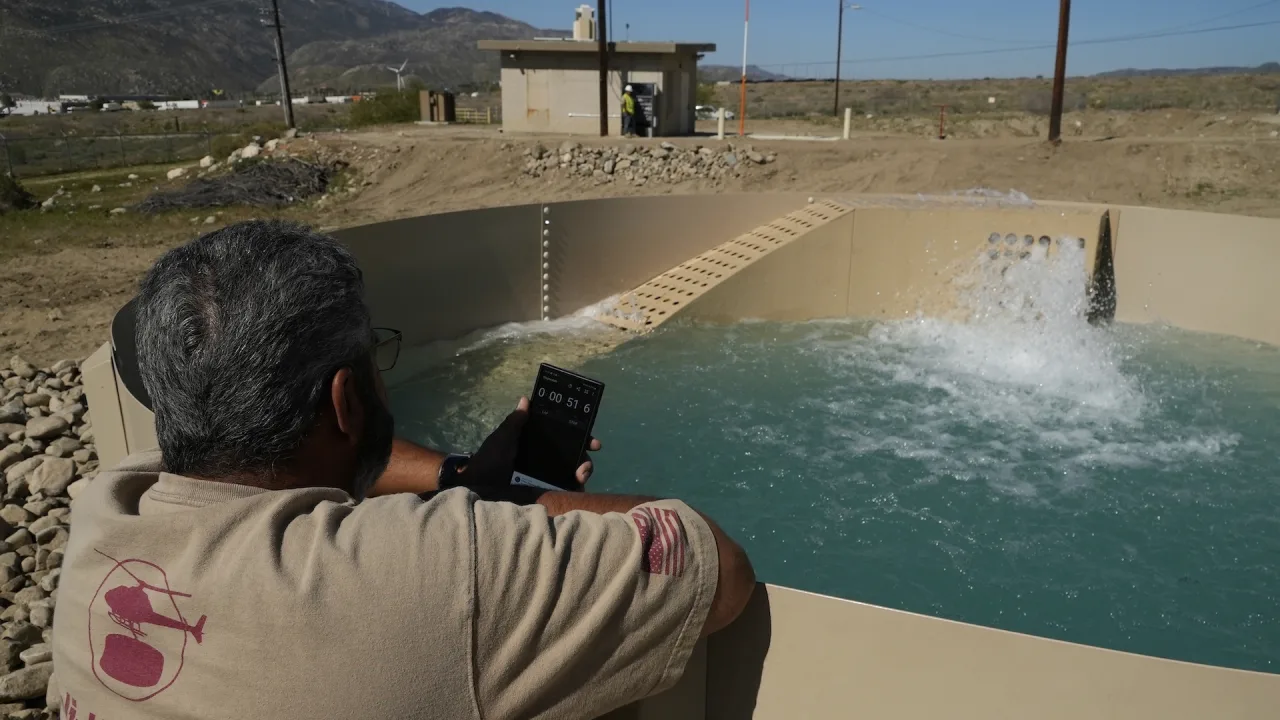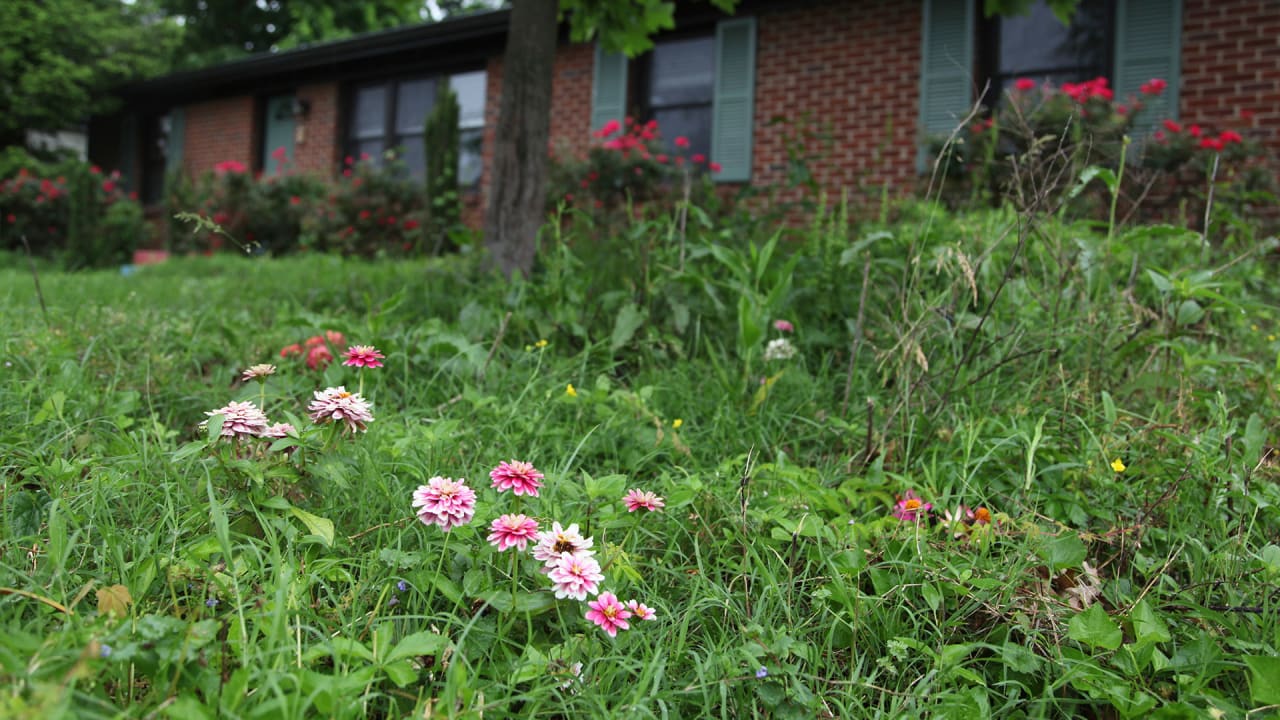A firefighter-invented hydrant for helicopters is boosting response times for urban fires
Mark Whaling and a crew raced up and down a hill in a tanker truck as they battled a wildfire in Los Angeles County, scrambling to get water from a street hydrant in time to stay ahead of flames moving up a ridge. A helicopter flew in to drop water, but it had to fly a long distance to refill—and a fire that might have been stopped went on to destroy homes.
As they fought that early 2000s blaze, Whaling says, he spotted a sealed, million-gallon water tank nearby that firefighters had no way of accessing. He thought that was ridiculous.
“We don’t tell fire engines, ‘Protect the city and go find your own water.’ We put fire hydrants every 600 feet all around cities,” said Whaling, who has since retired from the county fire department. “But when it comes to the helicopters, we weren’t supporting them as robustly as we should.”
His frustration sparked an idea: the Heli-Hydrant, a relatively small, open tank that can be rapidly filled with water, enabling helicopters to fill up faster for urban fires rather than flying to sometimes distant lakes or ponds.
As wildfires become more frequent, Whaling’s invention is getting the attention of officials eager to boost preparedness. First used for the 2020 Blue Ridge Fire in Yorba Linda, 10 Heli-Hydrants have been built across Southern California and 16 more are in progress, according to Whaling.
Helicopters are essential for firefighting. They can drop 1,000 gallonsof water at once—some much more. That is far more than hoses can get on a fire all at once, and can be the best way to attack fires that are difficult for ground crews to reach.
But pilots sometimes have to fly a long way to scoop up water. And in drought-prone areas, natural sources can sometimes dry up or diminish, so they’re hard to draw from. In Southern California’s Riverside County, helicopters have had to fly up to 10 milesto find water, eating critical time from battling fires.
An innovative solution
On a remote plot in the Southern California town of Cabazon, contractor Glenn Chavez stood on a ladder and peered into an empty Heli-Hydrant. A radio in hand, he clicked a button to activate the system and watched as water roared into the tank. In about six minutes, it filled with 8,500 gallons.
Chavez, a general contractor, was testing the Cabazon Water District’s latest investment—a second Heli-Hydrant that local officials are counting on to help protect the town. At it cost slightly less than the average price of a single home in Cabazon.
“Living in a beautiful desert community, you’re going to have risks of fire,” said Michael Pollack, the district’s general manager. “And to have these Heli-Hydrants is a major advantage. People will have a little bit of comfort knowing that they have another tool for fighting fires in their community.”
Pilots can remotely activate the tanks from half a mile away, with the tank typically filling quickly from a city’s water system. Helicopters can fill up in less than a minute. Once it’s activated, solar panels and backup batteries ensure the system can still be used during power outages. And at night, lights from the tank and a tower nearby guide pilots toward it.
In November, fire responders in San Diego put the product to the test when the 48-acre Garden Fire in Fallbrook, a community known for its avocado groves, prompted evacuation orders and warnings. Helicopters tapped the tank nearly 40 times.
Pilot Ben Brown said its proximity to the fire saved not just time but fuel.
“They’re great for when you don’t have other water sources,” he said. “The more dip sites, especially in some of the more arid environments in the county, the better.”
But they don’t always help
Heli-Hydrants have raised some concerns about their placement in urban areas where houses, buildings, and power lines can be obstacles to flight and they might have to squeeze into tighter spaces.
In those cases, firefighters may choose to fly farther to a natural source that gives the helicopter more room, said Warren Voth, a deputy pilot with the San Diego County Sheriff’s Department. A pilot’s goal is to always to face the wind while entering and exiting an area, for safety, and they need room to accomplish that.
In some cases, the municipal systems needed to fill Heli-Hydrants could go empty during major fires. As the Palisades Fire in Los Angeles burned, three 1-million gallon tanks that helped pressurize city hydrants in the Pacific Palisades ran dry as demand soared and burning pipes leaked water.
Other times, helicopters just can’t access them. When winds are fierce, flying is nearly impossible; hurricane-force winds that supercharged the Los Angeles infernos initially grounded firefighting aircraft. When multiple helicopters respond to large blazes, they can’t all use the Heli-Hydrant. And smoke can make it hard to see it.
Portable water tanks can accomplish some of the things that Heli-Hydrants do, but can require time, people, and equipment to set up.
A Heli-Hydrant gives one community hope
Areas where wildland vegetation intersects with human development have always been vulnerable to fires, but more people are living in them today, and climate change is creating conditions that can make these regions drier and more flammable.
Jake Wiley has seen intensifying wildfires devastate his community. Two blazes—in 2007 and 2017—collectively scorched more than 400 structures in San Diego. The last one forced Wiley, now general manager for the Rainbow Municipal Water District, to evacuate.
That fire also prompted local agencies to install a Heli-Hydrant—and when the Garden Fire erupted in November, it played a big role helping firefighters protect homes.
“It seems like when you’ve seen the worst, you haven’t yet,” Wiley said. “Anything we can do helps.”
The Associated Press receives support from the Walton Family Foundation for coverage of water and environmental policy. The AP is solely responsible for all content. For all of AP’s environmental coverage, visit .
—By Dorany Pineda and Brittany Peterson, Associated Press
#firefighterinvented #hydrant #helicopters #boosting #responseA firefighter-invented hydrant for helicopters is boosting response times for urban fires
Mark Whaling and a crew raced up and down a hill in a tanker truck as they battled a wildfire in Los Angeles County, scrambling to get water from a street hydrant in time to stay ahead of flames moving up a ridge. A helicopter flew in to drop water, but it had to fly a long distance to refill—and a fire that might have been stopped went on to destroy homes.
As they fought that early 2000s blaze, Whaling says, he spotted a sealed, million-gallon water tank nearby that firefighters had no way of accessing. He thought that was ridiculous.
“We don’t tell fire engines, ‘Protect the city and go find your own water.’ We put fire hydrants every 600 feet all around cities,” said Whaling, who has since retired from the county fire department. “But when it comes to the helicopters, we weren’t supporting them as robustly as we should.”
His frustration sparked an idea: the Heli-Hydrant, a relatively small, open tank that can be rapidly filled with water, enabling helicopters to fill up faster for urban fires rather than flying to sometimes distant lakes or ponds.
As wildfires become more frequent, Whaling’s invention is getting the attention of officials eager to boost preparedness. First used for the 2020 Blue Ridge Fire in Yorba Linda, 10 Heli-Hydrants have been built across Southern California and 16 more are in progress, according to Whaling.
Helicopters are essential for firefighting. They can drop 1,000 gallonsof water at once—some much more. That is far more than hoses can get on a fire all at once, and can be the best way to attack fires that are difficult for ground crews to reach.
But pilots sometimes have to fly a long way to scoop up water. And in drought-prone areas, natural sources can sometimes dry up or diminish, so they’re hard to draw from. In Southern California’s Riverside County, helicopters have had to fly up to 10 milesto find water, eating critical time from battling fires.
An innovative solution
On a remote plot in the Southern California town of Cabazon, contractor Glenn Chavez stood on a ladder and peered into an empty Heli-Hydrant. A radio in hand, he clicked a button to activate the system and watched as water roared into the tank. In about six minutes, it filled with 8,500 gallons.
Chavez, a general contractor, was testing the Cabazon Water District’s latest investment—a second Heli-Hydrant that local officials are counting on to help protect the town. At it cost slightly less than the average price of a single home in Cabazon.
“Living in a beautiful desert community, you’re going to have risks of fire,” said Michael Pollack, the district’s general manager. “And to have these Heli-Hydrants is a major advantage. People will have a little bit of comfort knowing that they have another tool for fighting fires in their community.”
Pilots can remotely activate the tanks from half a mile away, with the tank typically filling quickly from a city’s water system. Helicopters can fill up in less than a minute. Once it’s activated, solar panels and backup batteries ensure the system can still be used during power outages. And at night, lights from the tank and a tower nearby guide pilots toward it.
In November, fire responders in San Diego put the product to the test when the 48-acre Garden Fire in Fallbrook, a community known for its avocado groves, prompted evacuation orders and warnings. Helicopters tapped the tank nearly 40 times.
Pilot Ben Brown said its proximity to the fire saved not just time but fuel.
“They’re great for when you don’t have other water sources,” he said. “The more dip sites, especially in some of the more arid environments in the county, the better.”
But they don’t always help
Heli-Hydrants have raised some concerns about their placement in urban areas where houses, buildings, and power lines can be obstacles to flight and they might have to squeeze into tighter spaces.
In those cases, firefighters may choose to fly farther to a natural source that gives the helicopter more room, said Warren Voth, a deputy pilot with the San Diego County Sheriff’s Department. A pilot’s goal is to always to face the wind while entering and exiting an area, for safety, and they need room to accomplish that.
In some cases, the municipal systems needed to fill Heli-Hydrants could go empty during major fires. As the Palisades Fire in Los Angeles burned, three 1-million gallon tanks that helped pressurize city hydrants in the Pacific Palisades ran dry as demand soared and burning pipes leaked water.
Other times, helicopters just can’t access them. When winds are fierce, flying is nearly impossible; hurricane-force winds that supercharged the Los Angeles infernos initially grounded firefighting aircraft. When multiple helicopters respond to large blazes, they can’t all use the Heli-Hydrant. And smoke can make it hard to see it.
Portable water tanks can accomplish some of the things that Heli-Hydrants do, but can require time, people, and equipment to set up.
A Heli-Hydrant gives one community hope
Areas where wildland vegetation intersects with human development have always been vulnerable to fires, but more people are living in them today, and climate change is creating conditions that can make these regions drier and more flammable.
Jake Wiley has seen intensifying wildfires devastate his community. Two blazes—in 2007 and 2017—collectively scorched more than 400 structures in San Diego. The last one forced Wiley, now general manager for the Rainbow Municipal Water District, to evacuate.
That fire also prompted local agencies to install a Heli-Hydrant—and when the Garden Fire erupted in November, it played a big role helping firefighters protect homes.
“It seems like when you’ve seen the worst, you haven’t yet,” Wiley said. “Anything we can do helps.”
The Associated Press receives support from the Walton Family Foundation for coverage of water and environmental policy. The AP is solely responsible for all content. For all of AP’s environmental coverage, visit .
—By Dorany Pineda and Brittany Peterson, Associated Press
#firefighterinvented #hydrant #helicopters #boosting #response














